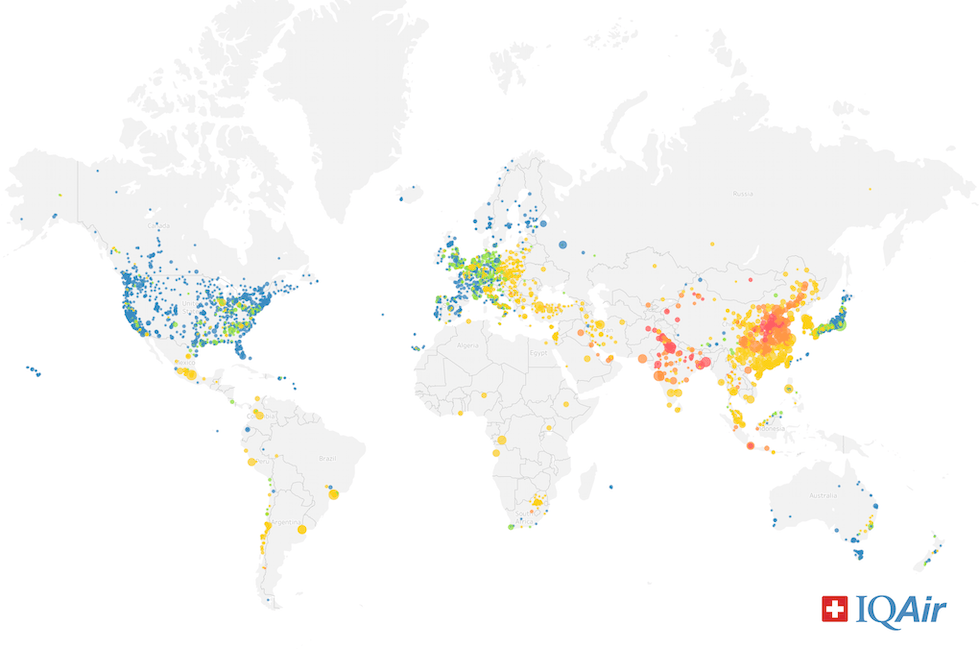Nine out of ten people are now breathing polluted air and, according to a new report, the cities that are struggling the most are located in India.

The “World Air Quality Report” found that of the 30 cities with the highest air pollution in the world, 21 are in India. Bangladesh was found to be the country with the most air pollution on the planet, South Korea within the OECD and Bosnia-Herzegovina in Europe.
The report was prepared by IQAir, a Swiss-US platform that specializes in technology solutions to protect people from airborne pollutants. The work, while not published in a peer-reviewed journal, is quite comprehensive. It includes a world ranking of 4,680 cities and another of 98 countries based on fine particle data (PM2.5) and collected last year by ground stations for air quality control.
“While the new coronavirus is dominating headlines, a silent killer is contributing to nearly 7 million more deaths a year: air pollution. Through compiling and visualizing data from air quality monitoring stations, the report gives new context to the world’s leading environmental health threat,” said Frank Hammes, IQAir CEO, in a press release.
The city with more air pollution in the world is Ghaziabad (India), with an average of 110.2 micrograms per cubic meter during 2019, which is 11 times more than the 10 micrograms per cubic meter per year recommended by the World Organization of the Health (WHO) for citizens to breathe healthy air.
Hotan (China), with 110.1 micrograms per cubic meter, is a close second, just ahead of Gujranwala (Pakistan), Faisalabad (Pakistan) and New Delhi (India), which is the first national capital on the list. Four other Indian cities (Noida, Gurugram, Great Noida and Bandhwari) complete the ‘top ten’, as well as another Pakistani (Raiwind).
In addition to the six locations mentioned, India contributes another 15 more in the top 30 positions — it’s shocking that 21 out of the 30 most polluted cities are in India (at least considering PM2.5).
From then on, Chinese municipalities begin to proliferate. A myriad of Chinese cities (including large ones) have extremely poor air quality.
As for Europe, the classification is headed by Lukavac (Bosnia-Herzegovina), followed by Valjevo (Serbia) and three other Bosnian cities: Tuzla, Zenica, and Sarajevo.
There was some positive news in the report as well. Although they’re still a ways away from acceptable levels, Chinese cities saw an overall improvement, with a 9% decrease in the concentration of pollutants compared to last year. Beijing, for example, halved its pollution levels over the past decade and is no longer one of the most 200 polluted cities. Furthermore, much of central and Eastern Europe has acceptable or almost acceptable air quality. Scandinavia, despite being highly developed, boasts generally clean cities.
The report indicated that air pollution levels are affected by weather and climate events, such as sandstorms and forest fires, and rapid urbanization in Southeast Asian regions, among other causes. Urgent action is needed to tackle these emissions sources, the report argued.
Air pollution is the most pressing environmental health risk in the world since it is estimated that it contributes to seven million premature deaths a year and it is believed that 92% of the planet’s population breathes unhealthy air, according to WHO. These deaths cost around 4.6 billion euros in losses in global terms.
People suffer both short-term and long-term health effects from air pollution, causing diseases and complications in nearly every system of the body. Some of these include respiratory diseases, eye irritation, skin diseases, cancer and birth defects.


